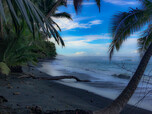
Greetings from Costa Rica!
Rainy season in Costa Rica
At the beginning of my trip I was in Puerto Jimenez, a small town with two streets, small huts, sometimes bigger, small shops and only one supermarket. Shortly after Puerto Jimenez, the unpaved roads begin with lots of holes, because the rain here is heavy and takes a piece of the road every time - and it rains a lot here. The tourist guides always say that the best time to travel to Costa Rica is between December and April, when it is dry. I disagree: the best time is during the big rains.
Even while I was there, big rains fell again and again. It pelted for hours. I sat on my covered terrace, listening, watching. In general, the country is full of water, rivers and streams everywhere. The most important utensil when you leave the house: Umbrella. At the same time, it's pleasantly warm, even humid, but because of the sea you don't feel it's oppressive.
Trip to Corcovado National Park
So Puerto Jimenez is a small town on the Gulf of Golfito, currently often under water, with a few tourists and a few, somewhat run-down hotels. Yet it is one of the few places to get to one of the most exciting national parks in Costa Rica, if not the world: Corcovado National Park. Corcovado National Park is about 42,000 ha of wild nature on the Osa Peninsula, right on the Pacific Ocean. It is the only national park where a jaguar can still hunt turtles or seabirds on the beach. We even have a video on our website of such a moment in Corcovado - a jaguar hunting on the beach.
In the park itself there are a few paths and navigable rivers for tourists, but they are only allowed into the park with a guide. The rest of the park is wild and untouched. But untouched is relative, because 60 years ago, most of what is now the national park was pastureland. But thanks to intensive conservation efforts, nature was able to develop freely here again. This resulted in the creation of one of the most unique and species-rich places in the world. More than five percent of the world's animal population live here in a very small area. Examples like these show time and again that important biotopes can be created if nature is given space again and allowed to develop largely free of human influence.
Our project
We want to connect the Corcovado Park with the Amistad National Park in the interior. La Amistad means friendship and probably comes from the fact that the protected area extends from Costa Rica (194,000 ha) to Panama (there are 207,000 ha protected area), a total protected area of about 400,000 ha or a good 4,000 km². There are a few trails for which you need a local guide, but otherwise this national park is hardly accessible.
The national park ranges from 100 m to 3,594 m above sea level. There are different ecoregions, ranging from lowland rainforest to upland secondary forest to tundra. Very rare species occur here, including the harpy eagle. We remember what a sensation it was when the first breeding pair of harpies was discovered in one of our projects, Patuca National Park in Honduras. Here in La Amistad - incidentally also in Corcovado - they officially exist. The very rare bush dog is also found here. Bush dog ...? Never heard before, is also no wonder, because it is really very rare. There are only estimates of the number of individuals, 110,000 widely distributed from Costa Rica to almost all of Latin America. Tendency, decreasing. But here, in La Amistad, it occurs, just like the Great Anteater. Also all six species of predatory cats of Central America live in this large park: jaguar and puma, yes, are known. Then the Jaguarundi, who knows Naturefund longer, knows that we once supported a project for the Jaguarundi in Nicaragua. Finally, the ocelot, the tigrillo (also dwarf ocelot) and the margay. In addition, 600 bird, 300 reptile, 200 mammal, 500 tree (all of Europe has only about 450 of them!), 500 orchid species are native here, and so on. And these are just the preliminary numbers. Because the park is so inaccessible, there is certainly still a lot to discover here.
The Corovado and the Amistad National Park: I have measured on the Internet on a map once, that are only 80 km distance, should go, I thought, and so the idea arose to connect the two national parks. That's why I'm here, for this project.
Share now:




